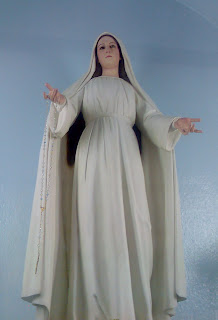The Four Marian Dogmas Part 1

There are four dogmas stating Mary's personal relationship with God and her role in human salvation .
1) Divine Motherhood
Mary's divine motherhood was proclaimed at the Council of Ephesus in 431.
Various names are used to describe Mary's role as mother of Jesus. She is called "Mother of God" which translates the more accurately stated greek term "Theotokos" or "Birthgiver of God."
The Council of Ephesus (431) attributed to Mary the title, Mother of God. This needs to be read against the Council's declaration that in Christ there are two natures, one divine and one human, but only one person. Indeed, according to the Council the holy virgin is the Mother of God since she begot according to the flesh the Word of God made flesh. This decision was further explained by the Council of Chalcedon (451) which says with regard to Mary's divine motherhood:
"...begotten from the Father before the ages as regards his godhead, and in the last days, the same, because of us and because of our salvation begotten from the Virgin Mary, the Theotokos, as regards his manhood; one and the same Christ, Son, Lord, only-begotten..."
Mary's Divine Motherhood was not the object of an independent or exclusive dogmatic declaration. The statement is embedded in texts defining the person and natures of Jesus Christ. Thus, the dogma of Divine Motherhood becomes an integral part of the christological dogma. This does not diminish its definitive and binding character. The dogma of Divine Motherhood is generally accepted by all Christian denominations.
2) Perpetual Virginity
The expression perpetual virginity, ever-virgin, or simply "Mary the Virgin" refers primarily to the conception and birth of Jesus. From the first formulations of faith, especially in baptismal formulas or professions of faith, the Church professed that Jesus Christ was conceived without human seed by the power of the Holy Spirit only. Here lies the decisive meaning of expressions such as "conceived in the womb of the Virgin Mary," "Mary's virginal conception," or "virgin birth." The early baptismal formula (since the 3rd century) state Mary's virginity without further explaining it, but there is no doubt about its physical meaning. Later statements are more explicit. Mary conceived "without any detriment to her virginity, which remained inviolate even after his birth" (Council of the Lateran, 649).
Although never explicated in detail, the Catholic Church holds as dogma that Mary was and is Virgin before, in and after Christ's birth. It stresses thus the radical novelty of the Incarnation and Mary's no less radical and exclusive dedication to her mission as mother of her Son, Jesus Christ. Vatican II reiterated the teaching about Mary, the Ever-Virgin, by stating that Christ's birth did not diminish Mary's virginal integrity but sanctified it . The Catechism of the Catholic Church ponders the deeper meaning of the virgin bride and perpetual virginity (499-507). It also maintains that Jesus Christ was Mary's only child. The so-called "brothers and sisters" are close relations.
1) Divine Motherhood
Mary's divine motherhood was proclaimed at the Council of Ephesus in 431.
Various names are used to describe Mary's role as mother of Jesus. She is called "Mother of God" which translates the more accurately stated greek term "Theotokos" or "Birthgiver of God."
The Council of Ephesus (431) attributed to Mary the title, Mother of God. This needs to be read against the Council's declaration that in Christ there are two natures, one divine and one human, but only one person. Indeed, according to the Council the holy virgin is the Mother of God since she begot according to the flesh the Word of God made flesh. This decision was further explained by the Council of Chalcedon (451) which says with regard to Mary's divine motherhood:
"...begotten from the Father before the ages as regards his godhead, and in the last days, the same, because of us and because of our salvation begotten from the Virgin Mary, the Theotokos, as regards his manhood; one and the same Christ, Son, Lord, only-begotten..."
Mary's Divine Motherhood was not the object of an independent or exclusive dogmatic declaration. The statement is embedded in texts defining the person and natures of Jesus Christ. Thus, the dogma of Divine Motherhood becomes an integral part of the christological dogma. This does not diminish its definitive and binding character. The dogma of Divine Motherhood is generally accepted by all Christian denominations.
2) Perpetual Virginity
The expression perpetual virginity, ever-virgin, or simply "Mary the Virgin" refers primarily to the conception and birth of Jesus. From the first formulations of faith, especially in baptismal formulas or professions of faith, the Church professed that Jesus Christ was conceived without human seed by the power of the Holy Spirit only. Here lies the decisive meaning of expressions such as "conceived in the womb of the Virgin Mary," "Mary's virginal conception," or "virgin birth." The early baptismal formula (since the 3rd century) state Mary's virginity without further explaining it, but there is no doubt about its physical meaning. Later statements are more explicit. Mary conceived "without any detriment to her virginity, which remained inviolate even after his birth" (Council of the Lateran, 649).
Although never explicated in detail, the Catholic Church holds as dogma that Mary was and is Virgin before, in and after Christ's birth. It stresses thus the radical novelty of the Incarnation and Mary's no less radical and exclusive dedication to her mission as mother of her Son, Jesus Christ. Vatican II reiterated the teaching about Mary, the Ever-Virgin, by stating that Christ's birth did not diminish Mary's virginal integrity but sanctified it . The Catechism of the Catholic Church ponders the deeper meaning of the virgin bride and perpetual virginity (499-507). It also maintains that Jesus Christ was Mary's only child. The so-called "brothers and sisters" are close relations.
Labels: Articles, Marian Dogmas


0 Comments:
Post a Comment
Subscribe to Post Comments [Atom]
<< Home